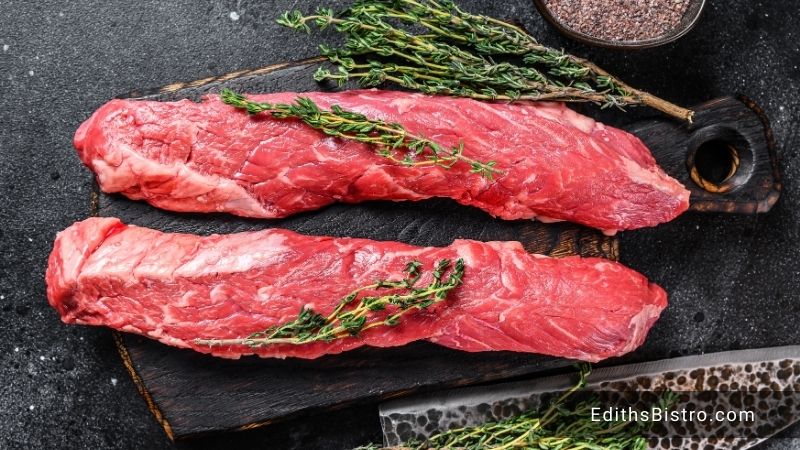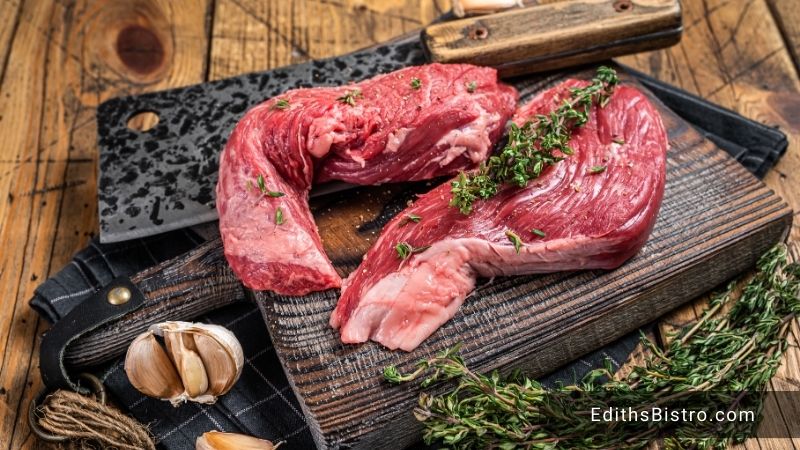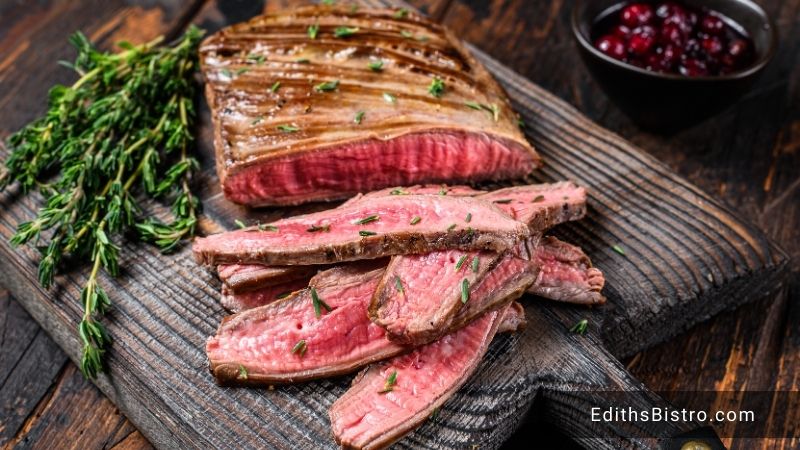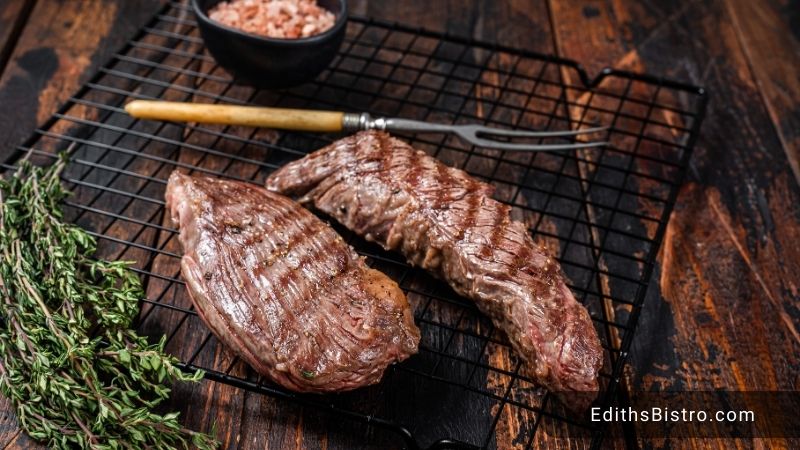When it comes to savoring a mouthwatering steak, most of us are familiar with popular cuts like ribeye, sirloin, or filet mignon. However, the world of beef offers many options beyond these well-known choices. One such hidden gem is bavette steak.
In this article, answer “What is bavette steak?” and discover its unique characteristics, how to cook this cut of meat to perfection, and why it deserves a place on your plate.
What Is Bavette Steak? Everything You Should Know!
Bavette steak, sometimes called flap meat, skirt steak, or sirloin tip, is a flavorful piece of meat that hails from the lower abdominal area of the cow, specifically the flank region. This cut is distinct due to its rich marbling, long muscle fibers, and deep, beefy flavor. Bavette steak is also called flank steak or flap steak in some regions. Additionally, this type of steak is more affordable than other cuts.
What cut is bavette steak?
Technically, bavette steak is carved from the bottom sirloin precisely at the intersection of the sirloin, short loin, and flank. This location is deeper within the cow’s anatomy, away from the exterior, and features less frequently exercised muscles.
On the other hand, the region from which bavette is sourced boasts an optimal fat ratio. This fat content significantly contributes to the steak’s tenderness and flavor profile, making it a delightful choice for those seeking a juicy steak that excels in both taste and texture.

Is bavette steak the same as flank steak?
Bavette and flank steak are similar cuts of beer, but they are not exactly the same. They come from neighboring cow regions and have some flavor, tenderness, and texture differences.
Generally, the most different feature of bavette and flank steak is their tenderness. Bavette steak comes from the bottom sirloin, where muscles experience less exercise.
Thus, bavette steak tends to be more tender than flank steak, as it remains in a relaxed state. Meanwhile, the flank area of the cow undergoes frequent exercise, leading to the buildup of muscle fibers and a decrease in fat content. Consequently, flank steaks are tougher cuts and require more precision when cooking.
However, both bavette and flank steaks are not the cuts of steak for eating with braces since they tend to be chewier than other premium steak cuts.
Why is it called bavette?
The name “bavette” has its origins in the French language and can be translated to “bib” or “apron” in English. This French name comes from the distinctive shape of the steak when it’s in its whole form.
Bavette steak is known for its elongated and flat appearance, somewhat resembling an apron or bib, which is how it earned its name.
In French cuisine, where various steak cuts have specific names and recognition, bavette stands out due to its recognizable shape and exceptional flavor.

What Is Bavette Steak Good For?
Bavette steak is a highly versatile cut of beef coming from abdominal muscles of the cow. It is suitable for many culinary applications thanks to its rich flavor and distinctive texture.
Here are several ways to enjoy bavette steak that you should try:
- Grilling: Its thin, flat profile makes it perfect for quick and even cooking over high heat. Marinate it with your preferred seasonings, grill to your desired level of doneness, and then slice it thinly for a delectable grilled steak experience.
- Pan-Searing: Another fantastic cooking method for bavette steak is pan-searing. Heat up a skillet with some oil and butter, then sear the steak to develop a flavorful crust while preserving the juicy interior. Season with salt, pepper, and herbs to enhance the steak’s taste.
- Fajitas: Bavette steak’s unique texture and flavor make it an ideal choice for fajitas. After cooking, thinly slice the steak and serve it alongside sautéed bell peppers and onions. Wrap it all in tortillas for a mouthwatering fajita feast.
- Stir-Frying: Slice bavette steak into thin strips to incorporate it into stir-fry dishes. Its robust flavor pairs beautifully with various vegetables and stir-fry sauces. Serve the stir-fry over rice or noodles for a quick and flavorsome meal.
- Asian-Inspired Dishes: Utilize bavette steak in Asian-inspired recipes such as beef and broccoli or beef with garlic sauce. Its texture and flavor harmonize perfectly with these savory dishes.
- Milanesa: Bavette steak is one of the best cuts to make Beef Milanesa – a famous South American dish. The robust and beefy flavor of this steak will be well-suited for Mexican Milanesa recipes.

How To Choose The Perfect Bavette Steak?
Selecting the perfect bavette steak is an art, and it involves considering several important factors to ensure you get a cut that meets your culinary preferences and cooking needs. Here is a guide on how to make the ideal choice:
- Freshness check: Verify the steak’s freshness by inspecting the sell-by or use-by-date on the packaging. Also, you can check the appearance of bavette steak to ensure its freshness. Choose a cut with a vibrant, deep red hue color.
- Consider thickness: Choose the steak’s thickness based on your intended cooking method. Thicker cuts are well-suited for grilling, while thinner ones work better for pan-searing or stir-frying.
- Grass-Fed vs. Grain-Fed: While grass-fed beef is leaner with lower levels of total fat, saturated fat, and calories, grain-fed bavette steak is juicier with a more tender texture and richer flavor.
- Grade matters: Keep in mind that bavette steak, like other cuts, may come with a grading system for quality. In the United States, the grading options are typically Prime, Choice, and Select, with Prime being the highest quality. Prime-grade bavette steak offers the most marbling and tenderness.
The Best Bavette Steak Recipe
Check the following video for a fantastic bavette steak recipe:
What To Serve With Bavette Steak?
Bavette steak, with its rich flavor and tender texture, pairs wonderfully with a variety of side dishes that complement its savory profile. Here are some delightful options to serve alongside bavette steak:
- Roasted Vegetables: Elevate your meal with a medley of roasted vegetables, such as asparagus, carrots, or Brussels sprouts. Toss them in olive oil, season them with your favorite herbs and spices, and roast them until they caramelize and become tender.
- Mashed Potatoes: Creamy mashed potatoes are a classic steak companion. For added depth, you can keep them simple with butter and cream or infuse them with flavors like garlic, horseradish, or fresh herbs.
- Grilled Corn on the Cob: For a taste of summer, grill corn on the cob until it’s charred and slightly sweet. Brush it with butter and sprinkle it with herbs or spices for extra flavor.
- Sautéed Mushrooms: Sautéed mushrooms, whether in a garlic-infused butter sauce or a savory wine reduction, enhance the steak’s earthy notes and make for an exquisite topping or side dish.
- Green Salad: A crisp green salad featuring mixed greens, cherry tomatoes, cucumbers, and a zesty vinaigrette provides a refreshing contrast to the steak’s richness.
- Garlic Bread or Baguette: Serve slices of garlic bread or a crusty baguette to soak up the succulent juices from the steak. You can also prepare garlic butter for spreading.
- Crispy Onion Rings: Crispy onion rings provide a delightful crunch and a hint of sweetness that pairs harmoniously with the savory steak.
- Coleslaw: Creamy coleslaw featuring shredded cabbage and carrots in a tangy dressing offers a refreshing counterpoint to the steak’s richness.
- Rice Pilaf: A fragrant rice pilaf infused with herbs, toasted nuts, and dried fruits adds an elegant touch to your steak dinner.
- Broccoli (grilled or steamed): Tender broccoli florets, lightly seasoned, provide a simple and nutritious side option that complements the steak.
- Quinoa Salad: A quinoa salad with vegetables, herbs, and a light dressing offers a wholesome and protein-rich choice to complement your bavette steak.

How To Store Bavette Steak?
Like other cuts, refrigeration and freezing are two main ways to store a bavette steak to keep it fresh and clean.
Refrigeration
This storage method is well-suited for short-term storage.
Upon purchase or receipt of bavette steak, place it in the refrigerator if you intend to use it within a few days. If the steak is vacuum-sealed or in an airtight package, you can store it as is. Otherwise, wrap it tightly in plastic wrap or aluminum foil to prevent exposure to air.
It’s best to use the bavette steak within 3-5 days of refrigeration for optimal taste and quality. The sooner it’s cooked, the fresher it will be.
Freezing
If you don’t plan to use the steak within the recommended time frame, freezing is an option to extend its shelf life. To freeze bavette steak:
- Remove it from its original packaging and pat it dry with paper towels to remove excess moisture.
- Wrap the steak securely in plastic wrap or aluminum foil. For long-term storage, consider using a vacuum-sealed bag if a freeze-proof container.
- Label the package with the date to monitor its freezing duration.
Ensure your freezer is set to a temperature of 0°F (-18°C) or lower to maintain food freshness and preserve the steak’s quality.
When properly frozen, bavette steak can remain suitable for consumption for 6-12 months. However, the quality may gradually diminish.
FAQs
What is bavette steak called in the USA?
Bavette steak is called flap steak in the USA. This is because bavette steak is sourced from the “flap” section of the bottom sirloin, and since “bavette” is not an English term, you will often find this cut labeled as “flap steak” in American grocery stores.
What is bavette steak called in Australia?
In Australia, people call bavette steak London Broil or Jiffy steak.
Is bavette steak a cheap cut?
Yes, bavette steak is generally considered a more affordable beef cut than premium cuts like ribeye or filet mignon. While it may not have the same tenderness as those premium cuts, bavette steak can be delicious when prepared and cooked correctly.
References:
- Wikipedia – Bavette – https://en.wikipedia.org/wiki/Bavette
- Wikipedia – Flank steak – https://en.wikipedia.org/wiki/Flank_steak






![What To Pair With Quiche? 25+ Best Dishes [With Pictures]](https://www.edithsbistro.com/wp-content/uploads/2024/04/what-to-pair-with-quiche-160x90.jpg)
